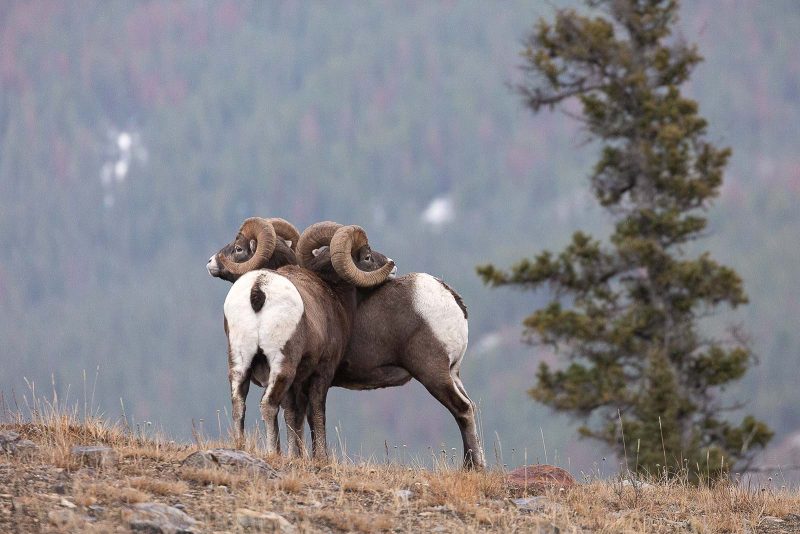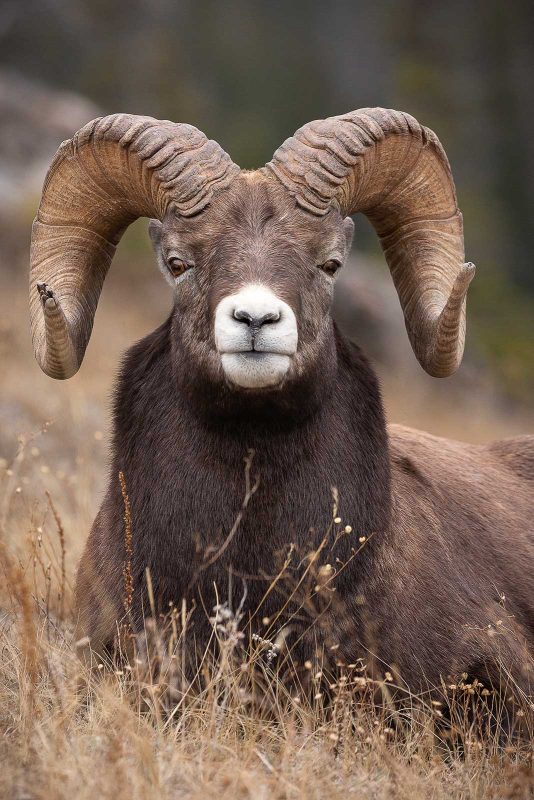How to Photograph Bighorn Sheep

There are several species of ungulates (hooved mammals) that call the Canadian Rockies home, including moose, elk, caribou, mule and white-tailed deer, and mountain goats. Bighorn sheep are also part of this group and are a fabulous subject to photograph all year round.
The bighorn sheep (Ovis canadensis) is a species of sheep native to North America, and the Rocky Mountain bighorn sheep is the subspecies that occupies the Canadian Rockies. The bighorn sheep gets its name from the large, curved horns of the male sheep (ram). The female bighorn sheep (ewe) also sports horns, but they are smaller and straighter than those of the males.


The horns on both sexes are not shed like those of other ungulates, such as moose and elk. Instead, they continually grow (albeit slower in the winter months and faster in the summer months), and are marked with growth rings. The rams, ewes, and lambs all have light to dark brown coats (lambs are usually a bit lighter in colour), along with white rump patches and white muzzles.
Rocky Mountain bighorn rams typically weigh between 128 and 315 pounds, whereas females are usually smaller, weighing between 75 and 201 pounds. The rams’ horns alone can reach weights of up to 30 pounds, which is quite amazing.
Bighorn sheep are popular subjects to photograph in the Canadian Rockies. Below are a few tips on how to capture engaging images of these beautiful animals.
Locating bighorn sheep in the Rockies
Mountainous pastures and grassy slopes are the preferred habitats of Rocky Mountain bighorn sheep. These areas usually have low to moderate snowfall, as it is difficult for sheep to move through and dig for grasses in deep snow. Preferably, the bighorn’s environment will include steep, rocky escarpments, which make it easier to escape from predators such as cougars and wolves.
Bighorn sheep can be found at different elevations depending on the time of year. They can be found at higher altitudes during the summer months, and their winter range is at lower elevations. Grasses and shrubbery are the main food sources for bighorn sheep, but in winter they will supplement their diets with minerals, using natural salt licks.
This need for salt is also the reason why, during the winter and spring months, bighorn sheep will often be seen on the highways that meander throughout the Rockies. Herds congregate on the roads to consume the salt put down to prevent ice build-up.
There are numerous places to see and photograph bighorn sheep in the Canadian Rockies. The national parks in both Alberta and British Columbia, including Banff National Park, Jasper National Park, and Kootenay National Park, are great spots to view bighorn sheep.
Read more: A Guide to Photographing Wildlife in Banff, Canada
The village of Radium Hot Springs, situated just outside the west entrance of Kootenay National Park, is a particularly popular spot. The area around the village is a wildlife corridor and, especially in the fall and winter months, a herd can often be found grazing right downtown.
Kananaskis Country, located approximately 75 kilometers west of Calgary, Alberta, and the Icefields Parkway, which connects Banff and Jasper National Parks, are other locations where bighorn sheep sightings are quite common.
When to photograph bighorn sheep
No matter the time of year, bighorn sheep make excellent photography subjects. However, the most popular time to photograph them is during the fall rut. The mating season of the bighorn sheep runs from November through December in the Rockies. This time of year provides photographers with ample opportunity to capture impressive displays of behaviour as the males engage in epic battles.
During the rut, bighorn rams (which spend the rest of the year in bachelor herds) join the ewes and lambs. The rams will then compete in demonstrations of dominance in order to mate with the ewes. These displays are impressive to witness.
Two rams will face off, rearing up slightly on their hind legs, and then will rush forward at great speed to literally ‘ram’ their massive horns together in a spectacular crash. The sound is immense, echoing off the mountainside.
Approximately six months after the fall rut, ewes will give birth to their lambs. The lambs are born in alpine meadows, which provide some protection from predators. The spring months can be a great time to photograph the connection between mother and young, and the innocence of the young lambs.
Bighorn sheep lambs are not only extremely cute and photogenic, but are also very curious and playful. They are often leaping and bounding about, which can make for excellent photo opportunities.
In addition to considering the time of year, it is also essential to consider what time of day is best to photograph bighorn sheep. Bighorns are generally most active during the daytime hours, retiring to bedding areas at night.
I find the mornings to be the best time to photograph these animals, as the soft light really helps to illuminate the amber colour of their eyes, and brings to life the texture of their brown coats.
Read more: Choosing the Best Lighting for Wildlife Photos
Equipment to photograph bighorn sheep
As bighorn sheep are often found atop knolls and cliffs, a set of binoculars is a must. What may appear to be a small spec on a clifftop could actually turn out to be a 275 pound ram.
As with several other ungulate species, keeping a safe distance is necessary when photographing bighorn sheep. Using a telephoto lens will allow you to get intimate shots without having to be physically close.
A zoom telephoto lens, such as a 100-400mm, a 150-600mm, or even a 70-200mm, is a great option as this will permit you to take both close-up portraits of these animals, and more environmental images.
Filling the frame with a ram’s head and horns can make for an impressive photograph, whereas using a shorter (wider) focal length can showcase the habitat in which these magnificent animals live. A zoom telephoto lens is also a practical option if you are hiking to high elevations to find bighorn sheep, as having a lighter pack with minimal lenses can be a life-saver.
Read more: What’s the Best Lens for Wildlife Photography?
Although not technically equipment, the most important thing you will need when photographing bighorn sheep is patience. Firstly, it will take time to locate these animals, often requiring a lengthy climb. Once with the sheep, getting the engaging image you are after might take hours.
Awaiting that right moment, whether that’s when the ewe’s eyes meet yours, or the lamb steps in front of a complementary and clean background, or the exact instant two rams crash together, will take time.
Understanding the behaviour of bighorn sheep
Understanding wildlife behaviour is essential when taking engaging wildlife photos. The more you know about the animal you are photographing, the better you will be at anticipating behaviour, and being ready to capture the moment.
As with other wildlife, knowing the signs of aggression or nervousness in bighorn sheep is key to keeping the encounter enjoyable and safe. Always stay a respectful distance away, especially during the rut when rams are most aggressive. The last thing you want is to be the recipient of a ram’s headbutt!
Equally as important as this is giving ewes and lambs space. If stressed, they will run off to protect their young, causing unnecessary distress. To make yourself less noticeable, approach bighorns slowly and wear dull colours to blend into the surroundings. Bighorn sheep have exceptional eyesight and will spot you easily if you are moving through their environment at too quick a pace.
Read more: 6 Tips for Better Fieldcraft in Wildlife Photography
Photographing bighorn sheep as silhouettes
As photographers we often want our subjects front lit, placing the sun behind us to light up the animal. With bighorn sheep it can be fun to play with light, and instead place the sun to the back of the sheep, creating a silhouette. This is often best done at sunrise or sunset.
The result will be that the bighorn becomes an outline of a shape, lacking colour and detail. These types of images can be dramatic and quite artistic. Creating silhouettes can also be a fun way to experiment and try something new.
Bighorn sheep are a great subject for silhouettes as, generally, you want to choose subjects that are easily recognizable as a dark outline. With their giant, curved horns, bighorn rams are perfect candidates. When photographing bighorns in this way, it is important to keep the frame simple and free from clutter.
In conclusion
When travelling or hiking through the Rockies, one of the highlights is spotting a herd of bighorn sheep. They are majestic and beautiful animals, and make for excellent subjects for both portrait and environmental images at any time of the year.













